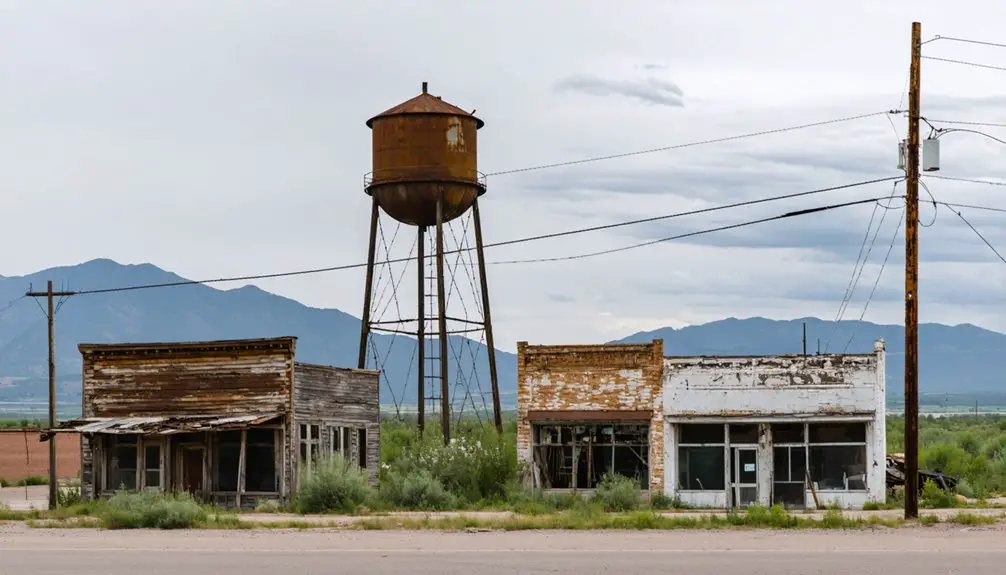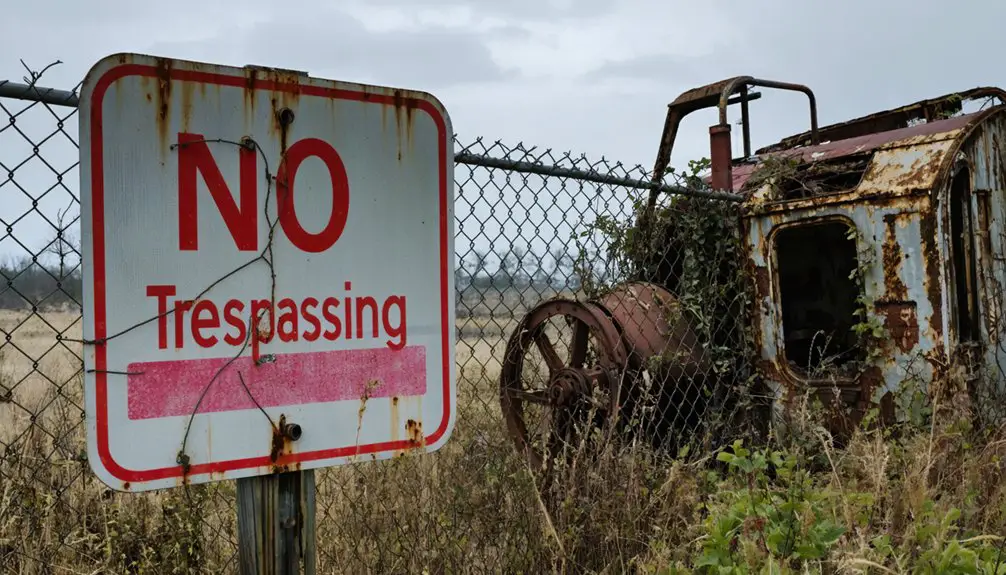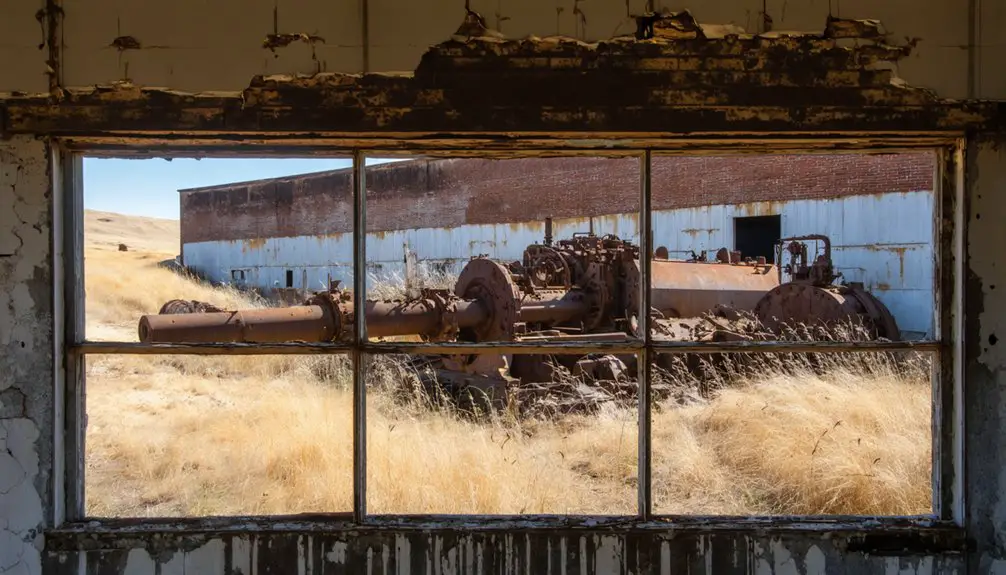You’ll find the remains of Hockerville nestled in Ottawa County, Oklahoma, where zinc and lead mining once created a bustling boomtown of 1,500 residents. Established in 1916 and named after Leslie C. Hocker, the town supplied 75% of America’s bullets during both World Wars. Today, toxic chat piles and abandoned ruins tell a cautionary tale of boom-and-bust mining, while scattered foundations hint at deeper stories buried beneath Oklahoma’s red earth.
Key Takeaways
- Hockerville was a thriving zinc and lead mining town established in 1916, reaching a population of 1,500 during its peak.
- Extensive mining operations created unstable underground caverns, leading to a catastrophic cave-in around 1950 that destroyed most buildings.
- Environmental damage from mining left toxic chat piles and contaminated water, forcing residents to abandon the town by the 1980s.
- The ghost town site now consists mainly of scattered ruins, with most original structures destroyed or deteriorated beyond recognition.
- Visitors can experience Oklahoma’s mining history through small group tours, though site access remains challenging due to safety concerns.
The Rise of a Mining Boom Town
When zinc and lead deposits were discovered in 1916, Hockerville quickly emerged as one of Oklahoma’s bustling mining communities. Named after Leslie C. Hocker, this young town exploded with opportunity as eighteen mines sprang up in the area.
You’d have found yourself among 1,500 residents who called this promising frontier home, each drawn by the social dynamics of a community built on mineral wealth.
The mining culture transformed this patch of Oklahoma into a powerhouse, playing a vital role in the Tri-State district’s dominance of global zinc production. By the mid-1920s, the area saw 248 operating mills processing ore around the clock.
Hockerville’s rich mineral deposits fueled the Tri-State district’s rise to global prominence in zinc production during the early 1900s.
By 1918, you’d have witnessed a “young, substantial, and progressive” city taking shape, complete with its own post office and a growing workforce. According to the free encyclopedia entry, Hockerville became a significant part of Oklahoma’s mining heritage.
Despite the hazardous conditions, miners flocked here, building their dreams one ore cart at a time.
Mining Operations and Economic Growth
You’ll find Hockerville’s early mining surge centered around the Baxter Mining Company‘s strategic leasing of over 1,160 acres to smaller operators by 1904.
Underground shaft mining dominated the landscape, with miners pumping groundwater continuously from the Boone aquifer to access rich deposits of lead and zinc ore. Like the rest of the Tri-State Mining District, these mining operations contributed to making Ottawa County the top global producer of lead and zinc by 1926. The extensive mining activities created vast chat piles that would later pose significant environmental challenges.
The district’s initial discoveries included sphalerite at 80 feet deep, which spurred rapid development of key operations like the Sunny Side and Dark Horse mines, transforming Hockerville into a bustling mining town.
Early Mining Boom Years
The discovery of rich lead and zinc deposits in 1916 transformed Hockerville from empty prairie into a bustling mining town almost overnight. You’d have witnessed mining technology rapidly advance as underground operations expanded, making this small Oklahoma town part of the world’s largest lead-zinc producing region by the 1920s. The miners faced constant danger as giant powder was used to break through rock formations.
The community’s resilience showed as the population swelled to 1,500 residents, with the post office opening in 1918 marking Hockerville’s official establishment. The town proudly bore the name of Leslie C. Hocker, reflecting its founding heritage.
You could’ve found work among the 11,000 miners who flooded the Tri-State Mining District by 1924. While nearby Picher hosted the smelter that processed the precious ore, Hockerville’s numerous mines and mills kept the economy booming.
The town’s prosperity directly tied to these mining operations, which sustained families and built a thriving community east of Picher.
Lead-Zinc Extraction Methods
Massive underground mining operations defined Hockerville’s approach to extracting valuable lead and zinc deposits from the earth.
You’d find miners working deep below the water table, where powerful pumps kept the Boone aquifer at bay so they could access the rich veins of galena and sphalerite. The mining technology was straightforward but effective – they’d sink shafts into the ground and follow the ore deposits wherever they led.
The ore processing didn’t stop at extraction. Once they’d hauled the raw material to the surface, mills would separate the precious metals from waste rock, creating massive piles of tailings locals called “chat.” These practices led to elevated lead levels in over 40% of local children during the 1980s.
During both World Wars, you could’ve taken pride knowing that 75% of America’s bullets and bombshells contained metals processed right here in the Tri-State district. Today, these former mining sites are part of Oklahoma’s Superfund redevelopment initiatives, transforming contaminated land into safer, productive spaces.
Daily Life in Early Hockerville
Life in early Hockerville revolved around the rhythms of the mines, as residents adapted to the demanding schedule of zinc and lead extraction that dominated the boomtown’s economy.
You’d find miners heading to work while their families managed households and kept the community running. The post office served as a hub where you’d catch up on news and collect mail, while local shops provided essential supplies for daily routines. Like many early settlers, miners from various European ethnic groups clustered around the valuable mineral deposits.
Community gatherings helped break up the challenging lifestyle, offering relief from the tough working conditions and basic living standards. Similar to early Oklahoma settlers who claimed 160-acre homesteads, residents carved out their own piece of the community.
Local gatherings provided essential respite from the demanding mine work, bringing neighbors together to share moments of joy amid daily struggles.
You’d face the harsh realities of hot summers and frigid winters, while always being mindful of ground instability from the extensive mining beneath your feet.
Despite these hardships, the close-knit mining community fostered strong social bonds through shared experiences.
Environmental Challenges and Health Risks
After decades of intensive mining operations, Hockerville’s landscape transformed into an environmental nightmare of towering chat piles and contaminated soil that you’d find impossible to ignore.
You’d see toxic dust blowing from mountains of mine waste reaching hundreds of feet high, while underground, acid-contaminated water turned Tar Creek blood-red. The devastation wasn’t just visual – it hit home when 43% of local children showed dangerous blood lead levels, leading to urgent health interventions in the 1980s and ’90s.
The ground beneath your feet wouldn’t even be stable, as old mine shafts created sinkholes that swallowed buildings whole.
Despite ongoing environmental restoration efforts since 1983, the toxic legacy forced residents to abandon their homes, leaving Hockerville a haunting reminder of mining’s brutal aftermath.
The Tar Creek Superfund Site Legacy

The toxic aftermath in Hockerville became part of a much larger environmental disaster known as the Tar Creek Superfund Site, spanning roughly 40 square miles across Oklahoma’s Ottawa County.
You’ll find a contamination history that dates back to the early 1900s, when lead and zinc mining dominated the region, producing over 55% of the world’s metals for a decade.
The remediation challenges you’re seeing today stem from decades of unrestricted waste disposal.
Decades of reckless dumping created a toxic legacy that haunts our cleanup efforts, poisoning the land with each passing year.
Those massive chat piles and contaminated water aren’t just eyesores – they’re actively leaching lead, zinc, and cadmium into your soil and water.
While the EPA’s been working since 1983 to clean up the mess, spending over $16 million annually, you’re still witnessing the effects of what many consider one of America’s most persistent environmental catastrophes.
Population Exodus and Community Decline
While Hockerville’s environmental woes dealt the final blow, you’ll find its population exodus began much earlier, rooted in the perfect storm of 1930s hardships.
Like many Oklahoma towns struggling with community resilience, Hockerville couldn’t escape the devastating combination of economic and environmental challenges that swept through the region.
Here’s what sealed Hockerville’s fate:
- The Dust Bowl and Great Depression forced residents to seek jobs on the West Coast
- Mining operations couldn’t sustain long-term population retention as resources depleted
- Young folks left for urban opportunities, leaving an aging population behind
- The closure of essential services created a downward spiral – no schools meant families couldn’t stay
You can trace similar patterns across Oklahoma’s rural landscape, where towns that couldn’t diversify their economies simply faded away, their stories echoing through empty streets.
Architectural Remains and Infrastructure

Looking at Hockerville today, you’d hardly recognize it as a once-bustling mining town. The architectural decay has been so complete that nearly all traces of the original buildings have vanished beneath thick brush and vegetation.
You won’t find the post office that served the community from 1918 to 1963, nor any of the commercial structures that once lined the main street.
The infrastructure remnants tell a stark tale of the town’s demise. A catastrophic cave-in around 1950 destroyed much of the core area, the result of extensive lead and zinc mining that created unstable caverns beneath the surface.
Unlike nearby ghost towns Cardin and Zincville, Hockerville’s structures couldn’t withstand the ground’s instability. All that’s left are scattered ruins, with no preserved buildings to mark this once-thriving community.
Educational System Through the Years
You’ll find Hockerville’s early education system began with informal schooling that served the children of mining families during the town’s population boom in the early 1900s.
As the mining community grew to 1,500 residents, local schools expanded to meet the needs of workers’ families, though they often shared educational services with nearby towns like Picher and Baxter Springs.
The eventual decline of mining operations led to the consolidation of area schools under Picher-Cardin Public Schools, which served the community until 2009 when environmental concerns and population loss forced students to transfer to Quapaw Public Schools.
Early School Facilities
As Hockerville’s mining community flourished in the early 1940s, its modest wooden schoolhouse served over 500 residents’ children with basic but essential education.
You’d find the centrally-located building bustling with activity, as teachers managed multiple grade levels in single rooms, adapting their mining curriculum to prepare youngsters for life in this rugged Oklahoma town.
Here’s what you’d experience in Hockerville’s early schoolhouse:
- Multi-grade classrooms where 1st and 2nd graders learned together, sharing limited resources.
- Practical lessons focused on mining community needs rather than remote learning concepts.
- Flexible school schedules that worked around the mine’s operating hours.
- Community gathering spaces that doubled as educational facilities, bringing families together.
The school’s simple structure reflected the town’s mining heritage, with wooden walls that witnessed generations of local children growing up in this tight-knit community.
Teacher-Student Population Changes
When Hockerville’s population peaked in the 1920s, teacher-student ratios reflected the town’s mining prosperity, with classrooms bursting at their wooden seams.
You’d find dedicated educators managing large groups of students, many from mining families who’d settled in the area hoping to strike it rich.
As Ottawa County’s population declined after 1950, you’ll notice how enrollment fluctuations dramatically impacted Hockerville’s school system.
Teacher retention became increasingly challenging as families moved away, forcing the district to adapt. They’d combine grade levels and reduce staff, a common practice you’d see in rural Oklahoma schools.
District Consolidation History
The consolidation of Hockerville’s school district marked a significant chapter in Oklahoma’s broader educational transformation.
Like many rural communities, Hockerville experienced the sweeping consolidation trends that reshaped Oklahoma’s educational landscape since 1903. You’ll find that these changes reflected larger shifts happening across the state as populations moved from rural to urban areas.
- Oklahoma’s consolidation journey began during the Great Depression when New Deal programs sparked school mergers.
- Post-WWII demographic changes pushed more rural districts to combine resources.
- By 1989, the state had dramatically reduced its districts to 609 through voluntary and mandatory consolidations.
- Local districts, like those in Tillman County, went from over 100 to just a handful by the 1930s.
The historical impacts forever changed how students learned, trading one-room schoolhouses for larger, centralized facilities.
Historical Preservation Efforts
Preserving Hockerville’s remaining history presents unique challenges due to catastrophic cave-ins from the 1950s that destroyed most above-ground structures.
You’ll find the site largely covered in brush and ruins today, with unstable underground mining caverns making preservation work dangerous. The town’s proximity to other mining ghost towns requires careful regional planning to manage scattered historical resources.
Despite these preservation challenges, tribal leadership and community involvement remain essential to conservation efforts.
You’ll see coordinated cleanup projects that respect both historical significance and tribal priorities, especially regarding cultural sites and natural resources like Beaver Creek.
When preservation teams gather, they honor the area’s heritage through stakeholder meetings and tribal celebrations before beginning any restoration work, ensuring the land’s spiritual and historical values are protected.
Modern-Day Ghost Town Tourism

Modern-day visitors seeking unique experiences now journey to Hockerville’s storied grounds, though in smaller numbers than during its mining heyday.
Ghost town tourism here offers a raw glimpse into Oklahoma’s mining past, where you’ll find authentic structures standing as silent witnesses to bygone prosperity.
For the best visitor engagement during your exploration:
- Visit during cultural events when local guides share compelling stories about the town’s mining legacy
- Pack your camera to capture the haunting beauty of weathered buildings and historical artifacts
- Join small group tours that protect the site while providing intimate historical insights
- Support local businesses in nearby communities that help preserve Hockerville’s heritage
While accessibility remains challenging, dedicated history buffs and adventure seekers continue making the trek to experience this atmospheric piece of Oklahoma’s past.
Frequently Asked Questions
Are There Any Remaining Residents Living in Hockerville Today?
Time waits for no one, and you’ll find zero current population in this once-bustling community. History shows everyone packed up after mining hazards and economic decline made living there impossible.
What Paranormal Activities or Ghost Stories Are Associated With Hockerville?
You’ll encounter ghost sightings throughout abandoned mines and buildings, with reports of shadowy figures, mysterious footsteps, unexplained voices, and cold spots. Local legends tell of haunted locations where miners’ spirits roam.
Can Visitors Legally Explore the Abandoned Buildings in Hockerville?
Like moths drawn to danger, you can’t legally explore Hockerville’s buildings. Exploration regulations prohibit entry due to severe safety hazards, and trespassing laws are strictly enforced to protect visitor safety.
What Valuable Artifacts Have Been Discovered in Hockerville’s Ruins?
Archaeological findings reveal calcite spears, zinc remnants, burnt pottery, buttons, bottles, and iron pots of historical significance. You’ll also find limestone chimneys, mining tools, and building foundations throughout the ruins.
Where Are Former Hockerville Residents and Their Descendants Now?
In a massive diaspora, former families scattered across northeast Oklahoma and southeast Kansas. You’ll find their descendant stories alive in nearby towns like Picher, Cardin, and Baxter Springs.
References
- https://www.wikiwand.com/en/articles/Hockerville
- https://en.wikipedia.org/wiki/List_of_ghost_towns_in_Oklahoma
- https://www.youtube.com/watch?v=FZJc5Ivk2J4
- https://www.mindat.org/sitegallery.php?loc=188938
- https://kids.kiddle.co/List_of_ghost_towns_in_Oklahoma
- https://www.youtube.com/watch?v=xg8SpCG-wDg
- https://www.okhistory.org/publications/enc/entry?entry=MI042
- https://www.ghosttowns.com/states/ok/hockerville.html
- http://ogs.ou.edu/docs/geologynotes/GN-V74N2.pdf
- https://panethos.wordpress.com/2023/08/07/picher-oklahoma-from-lead-zone-to-dead-zone/



